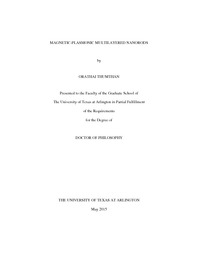| dc.description.abstract | Multilayered nanorods which consist of alternating magnetic layers separated by Au layers combine two distinctive properties, magnetic properties and surface plasmonic resonance (SPR) properties into one nano-entity. Their magnetic properties are tunable by changing the layer thickness, varying from single domain to superparamagnetic state. Superparamagnetic is a key requirement for magnetic nanoparticles for bioapplications. Superparamagnetic nanoparticles exhibit high magnetic moments at low applied magnetic field while retain no magnetic moments when magnetic field is removed preventing them from aggregation due to magnetic attraction. Au layers in the nanorods provide anchorage sites for functional group attachment. Also, Au nanodisks exhibit SPR properties. The SPR peak can be tuned from 540 nm to 820 nm by controlling the thickness of magnetic segments while keeping Au thickness constant. In this research, there are three types of multilayered nanorod have been fabricated: Au/NiFe nanorods, Au/Fe nanorods, and Au/Co nanorods. These magnetic nanorods were fabricated by templated electrodeposition into the channels in Anodic Aluminum Oxide (AAO) membrane. The setup for AAO fabrication was developed as a part of this research. Our fabricated AAO membrane has channels with a diameter ranging from 40nm to 80 nm and a thickness of 10um to 12um.Magnetic properties of nanorods such as saturation field, saturation moment, coercivity and remanence are able to manipulate through their shape anisotropy. The magnetization will be easier in long axis rather than short axis of particle. In addition, Au nanodisks in the nanorod structure are not only serving as anchorage sites for functional groups but also provide SPR properties. Under irradiation of light Au nanodisks strongly absorb light at SPR frequency which ranging from 540 nm to 820 nm by controlling the thickness of magnetic segments while keeping Au thickness constant. The SPR tunability of nanorods in near-infrared region can be used in in-vivo biomedical applications such as photo thermal therapy because tissue has an absorption maximum in the infrared range.The magnetic nanorods were explored for the following two applications: 1) as active component orientation-tunable ferrogel for cell culture matrix, 2) as MRI contrast agent. The results show that Au/NiFe magnetic nanorods can be aligned along applied magnetic field. Using MTT assay for 3T3 fibroblast cells, the biocompatibility of Au/Co nanorods was investigated. It shows that cell proliferation after 72 hours of incubation with nanorods decreases as the concentration of nanorods increases. However, cell viability quantified by counting dead cell/live cell reveals that only few cells died after three days of incubation. Au/Co multilayered nanorods were tested as T2 MRI-contrast agent, and a very large relaxivity was observed.In summary, we have successfully fabricated multilayered nanorods with tunability in both magnetic and SPR properties. These nanorods can potentially be used in biological and biomedical fields. | en_US |

